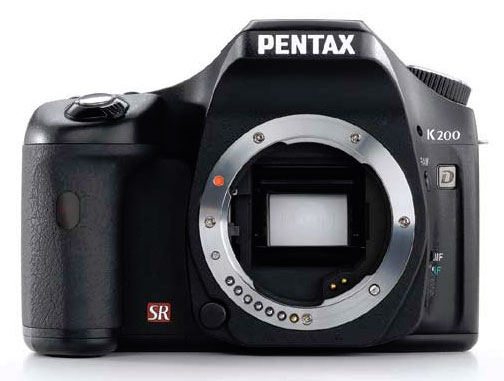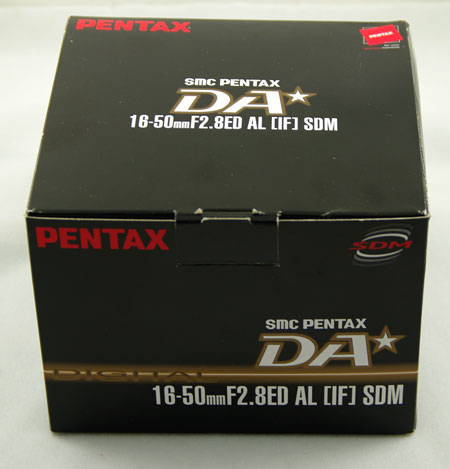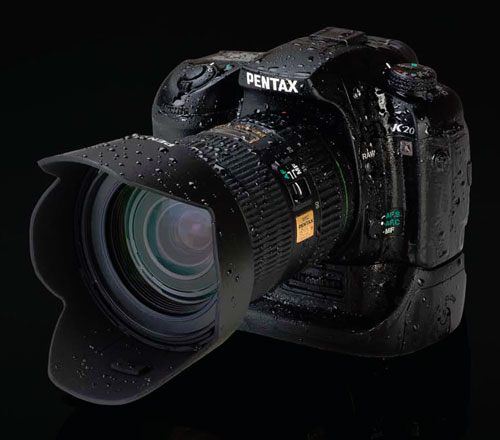SDM Motor Lens

Pentax announced they would introduce new motor lens technology, which they call DA* (pronounced DA star) SDM (Supersonic Drive Motor) when the K10D was launched about a year and a half ago. As you can see in the mount photo, there are two additional gold pins inside the mount that couple with the SDM lens motor. Without these pins the SDM lenses function like standard AF screw-drive lenses.

It was not until about five months ago that Pentax finally began shipping the new SDM motor lenses, and they require at least a K10D with an upgrade to firmware 1.30 for the motors to even work. As a result, almost no one took a closer look at the new Pentax motor lenses. Now with the K20D we have the first real opportunity to work with a Pentax motor lens, specifically the 16-50mm f2.8.
On a side note, we really wish the marketing guy who is so hell bent on using * would get over it (first "*ist D" and now "DA*"), because the realities in a computer world were not considered. * usually signifies a wildcard in computer lingo, which means these Pentax products with the clever little * name can't be searched in Google or other search engines. This makes it impossible (or at best very difficult) to find these specific Pentax products with a * in their name in a search engine or at a web retailer site. Clearly that wasn't the intent of Pentax, but someone in the company needs to realize it's a bad idea and not very helpful for their sales.

Back to the camera, we mounted the 16-50 DA* SDM and we were frankly blown away. We thought the lens was broken because we couldn't hear the autofocus motor at all during focusing. The focus was so fast we assumed it wasn't focusing but we quickly saw the lens was definitely focusing.
Our everyday cameras right now are a Canon 5D full-frame and 40D with Ultrasonic lenses and a couple of L lenses, and an Olympus E-3 with a Leica 25mm F1.4 and the new 12-60mm SWM lens. The Pentax DA* SDM is quieter than any of these cameras, including the 24-105mm Canon L. It is also subjectively as fast as or faster than any of these cameras with their best motor lenses. We were shooting test shots in my available darkness office and the DA* SDM AF performance was nothing short of remarkable.

The 16-50 f2.8 fast wide angle to short telephoto (24-75mm equivalent) features a lens motor and sealing against dust and moisture, just like the K10D and K20D camera bodies. At first glance, the street price of around $700 will seem very high until you compare it to similar offerings from Canon and Nikon. The 17-55mm f2.8 IS Canon will set you back $1000 or more and the Nikon 17-55 f2.8 is a healthy $1190. The Canon 16-35 f2.8 L is another comparable lens at $1370. By comparison the Pentax DA* 16-50mm f2.8 SDM, designed and built to similar Pro specs, is an absolute bargain.
This caused us to wonder how others would review the K20D. Most use the standard 50mm f1.4 lens from the manufacturer in testing Autofocus. The Canon 50mm is an Ultrasonic motor lens, while the Pentax 50mm is an old-style AF screw drive. Popular Photography modified their test procedure to accommodate the fast Olympus SWM motor in their E-3 review, but it is clear they didn't even bother to retest for the K20D and used older K10D launch AF numbers when SDM lenses were not even available. Unfortunately, that means their AF tests of the K20D are not comparable to Canon or Olympus or Nikon.

We are trying to determine how best to test AF to account for the improved performance of SDM. The point is that the first question for any review of the AF performance of the K20D should be whether it was tested with an SDM lens. If an SDM lens was not used the review is not measuring the K20D autofocus performance in an apples-to-apples comparison.










50 Comments
View All Comments
Tridion - Sunday, March 23, 2008 - link
Here is also some high iso images:http://highiso.net/images.php?Sort=isospeedratings...">http://highiso.net/images.php?Sort=isospeedratings...
Justin Case - Sunday, March 16, 2008 - link
As usual, we get a lot of specifications lifted from the camera's brochure, and a lot of images of the camera, but not a single photo taken with the camera. This is like reviewing Doom 4 by posting pictures of the box and DVD instead of screenshots from the game...shira - Wednesday, March 12, 2008 - link
Does the K20D have any special provision for cleaning the CMOS? A friend of mine with the Canon IDs Mark II (approximately same megapixel count as the K20D, though with a full-screen CMOS) complains how time-consuming it is to clean the CMOS on the camera, which becomes increasingly important as image quality increases. Canon has now implemented a "shake" function to clean the CMOS on the MK III version of the IDs, which represents a real time-saver. Does the K20D have a similar function?benplaut - Wednesday, March 12, 2008 - link
First of all, it has a "sensor shake," as do many newer camera (my K10D has this, too). Second, it has an anti-static coating over the lowpass, which does quite a bit of good. Finally, it has sticky spots around the mirror box to catch dust as it is shaken off--not sure how effective it all is, but I've yet to have a single dust spot on my K10D in three months of owning it. Of course, welded dust still needs to be wet cleaned.Kiwaiti - Friday, March 14, 2008 - link
Sensor shake is ideally suited to the Pentaxes because their sensors are positioned magnetically for the in-body shake reduction. I think my K20D shakes its sensor even more violently than K10Ds I've tried.In case manual cleaning is still necessary, there is a new feature on the K20D showing an image of the sensor with a representation of the surrounding mount as you see it when cleaning, the sensor showing black spots for dust on a white background. The dust map is also saved to a separate folder on the SD card.
gar655 - Tuesday, March 11, 2008 - link
The 17-55IS is NOT $1300. It's about $800, which is in line with the price of the 16-50 Pentax and Oly 12-60. It is not built as well as either, nor is it weather sealed.It is, however, much better optically than the Pentax 16-50 and as good or better than the Oly.
That said, the K20 looks like a great camera for the price, especially for landscape and portrait work.
Wesley Fink - Tuesday, March 11, 2008 - link
We went deeper than a cursory check of lens prices for this reply. Amazon.com is normally competitive with the the best legitimate price for lenses, and they are now $1100 for the 17-55mm IS. We also checked B&H which is currently $999. BTW B&H sells the Pentax for $699 and Amazon sells the Pentax for $679. With those prices we have changed the price for the Canon lens in our review to $1000.Since reviews of the Olympus 12-60mm have proclaimed it the lowest distortion zoom of its type ever tested your conclusion that the Canon is better optically sounds like wishful thinking. The Pentax lens is extremely sharp but it does have more distortion than the 17-55mm Canon, however, so we would likely accept your claim that the 17-55mm IS Canon is better optically. As you point out, though, it is not weather-sealed or built as well as the Pentax or Olympus lenses.
Hulk - Tuesday, March 11, 2008 - link
This Megapixel race in dSLR's is concerning me. This isn't a numbers game but a image quality issue.Please show some 100% crops of this Pentax verses the 40d and some other C sized sensor cameras. Please use prime lenses at F/8 to try and minimize lens variation effects.
Let's see how good this camera is on a per pixel basis.
haplo602 - Wednesday, March 12, 2008 - link
I would disagree, pisel peeping does not help much.It's the final print that matters, so you need to select a target print size and use the same printing technology and equipment for all contenders, then you can compare.
The megapixel race is a bit meh if it is not coupled with NR and dynamic range improvements to utilise the new resolution to the fullest.
Hulk - Wednesday, March 12, 2008 - link
I am not a pixel peeper. Great photography is about composition, light, shadow, and conveying emotion to the viewer. It's not about technology.But this camera review is about technology. I would like to see full scale comparisions as well but unless we look on a per pixel basis we don't know if the increases in sensor technology is keeping up with the mad race to advertise more pixels.
My money is hard earned and I'd like to see the pixels.
Plus I'm quite sure doing a comparision at equal size prints will show virually no difference until print sizes are large enough to start to discern pixels anyway. Then we'd be pixel peeping again!
The point of higher pixel count is increases resolution at higher print sizes right? So let's get to it and see at per pixel? I'm willing to be objective but I'd like to see both tests.